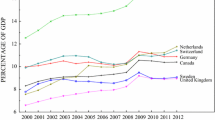Abstract
We examine how the market power of physician groups affects the form of their contracts with health insurers. We develop a simple model of physician contracting based on ‘behavioral economics’ and test it with data from two sources: a survey of physician group practices in Minnesota; and the physician component of the Community Tracking Survey. In both data sets we find that increases in groups’ market power are associated with proportionately more fee-for-service revenue and less revenue from capitation.
Similar content being viewed by others
References
Ackerberg D., Botticini M. (2002) Endogenous matching and the empirical determinants of contract form. Journal of Political Economy 110(3): 564–591
Allen D., Lueck D. (1995) Risk preferences and the economics of contracts. American Economic Review 85(2): 447–451
Bajari P., Tadelis S. (2001) Incentives versus transaction costs: A theory of procurement contracts. RAND Journal of Economics 32(3): 387–407
Brunt C. S., Jensen G. A. (2010) Medicare part B reimbursement and perceived quality of care. International Journal of Health Care Finance & Economics 10(2): 149–170
Decker S. L. (2007) Medicaid fees and the quality of medical care of medicaid patients in the USA. Review of Economics of the Household 5(1): 95–112
Devers K., Casalino L., Rudell L., Stoddard J., Brewster L., Lake T. (2003) Hospitals’ negotiating leverage with health plans: How and why has it changed. Health Services Research 38(1, Part2): 419–446
Ellis R., McGuire T. (1986) Provider behavior under prospective reimbursement: Cost sharing and supply. Journal of Health Economics 5(2): 129–151
Ellis R., McGuire T. (1990) Optimal payment systems for health services. Journal of Health Economics 9(4): 375–396
Evans R. G. (1974) Supplier-induced demand: Some empirical evidence and implications. In: Perlman M. (eds) The economics of health and medical care. Macmillan, London
Gabel J., Levitt L., Holve E., Pickreign J., Whitmore H., Dhont K., Hawkins S., Rowland D. (2002) Job-based health benefits in 2002: Some important trends. Health Affairs 21(5): 143–151
Gift T., Arnould R., DeBrock L. (2002) Is health competition health? New evidence of the impact of hospital competition. Inquiry 39(1): 45–55
Gowrisankaran G., Town R. (1999) Estimating the quality of care in hospitals using instrumental variables. Journal of Health Economics 18(6): 747–767
Hadley J., Reschovsky J. (2006) Medicare fees and physicians’ medicare service volume: Beneficiaries treated and services per beneficiary. International Journal of Health Care Finance and Economics 6(2): 131–150
Hurley R., Grossman J., Lake T., Casalino L. (2002) Longitudinal perspective on health plan-provider risk contracting. Health Affairs 21(4): 144–153
Holmstrom B., Milgrom P. (1987) Aggregation and linearity in the provision of incentives. Econometrica 55(2): 303–328
Kane, C. K. (2004). Physician marketplace report: The practice arrangements of patient care physicians, 2001. American Medical Association Center for Health Policy Research.
Kao A. et al (2001) Physician incentives and disclosure of payment methods to patients. Journal of General Internal Medicine 16(3): 181–188
Kralewski J., Dowd B., Heaton A., Kaissi A. (2005) The influence of the structure and culture of medical group practices on prescription drug errors. Medical Care 43(8): 817–825
Ma A.-C., McGuire T. (1997) Optimal health insurance and provider payment. American Economic Review 87(4): 685–704
McGuire, T. (2000). Physician agency. In A. Culyer, & J. Newhouse (Eds.), Handbook of health economics (pp. 461–536). Amsterdam: Elsevier Science.
Pauly, M. (1968). The economics of moral hazard. American Economic Review, 58(3), 531–537.
Pauly, M. (1995). Paying physicians as agents: Fee-for-service, capitation, or hybrids? In T. Abbott (Ed.) Health care policy and regulation (pp. 163–174). Boston: Kluwer Academic Publishers.
Schultz, J., Feldman, R., & Christianson, J. (2003). A family decision-making model of health insurance choices. Mimeograph, Division of Health Policy and Management, University of Minnesota.
Selden, T. (1990). A model of capitation. Journal of Health Economics, 9(4), 397–409.
Seldon, B., Jung, J., & Cavozos, R. (1998). Market power among physicians in the U.S. Quarterly Review of Economics and Finance, 38(4), 799–824.
Strunk, B., & Reschovsky, J. (2002). Kinder and gentler: Physicians and managed care, 1997–2001. Center for Studying Health System Change, Tracking Report No. 5.
Thaler, R., & Shefrin, H. (1981). An economic theory of self-control. Journal of Political Economy, 89(2), 392–406.
Thurston, N. (2001). Physician market power—evidence from the allocation of malpractice premiums.Economic Inquiry, 39(3), 487–498.
Town, R., & Vistnes, G. (2001). Hospital competition in HMO networks. Journal of Health Economics, 20(5), 733–753.
Town, R., Wholey, D., Krawelski, J., & Dowd, B. (2004). Assessing the influence of incentives on physicians and group practices.Medical Care Research and Review, 61(9), 80S–118S.
Zeckhauser, R. (1970). Medical insurance: The trade-off between risk spreading and appropriate incentives. Journal of Economic Theory, 2(1), 10–26.
Author information
Authors and Affiliations
Corresponding author
Rights and permissions
About this article
Cite this article
Town, R., Feldman, R. & Kralewski, J. Market power and contract form: evidence from physician group practices. Int J Health Care Finance Econ 11, 115–132 (2011). https://doi.org/10.1007/s10754-011-9091-9
Received:
Accepted:
Published:
Issue Date:
DOI: https://doi.org/10.1007/s10754-011-9091-9




